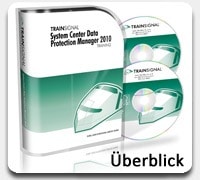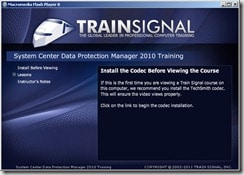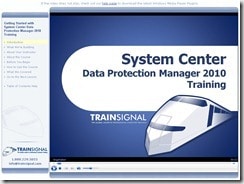 Willkommen zu einer weiteren Zusammenfassung eines Videotutorials von TrainSignal.
Willkommen zu einer weiteren Zusammenfassung eines Videotutorials von TrainSignal.
Diesmal geht es um den System Center Data Protection Manager, kurz DPM.
Der DPM ist eine umfangreiche und umfassende Backupsoftware aus der System Center Familie. Er stellt eine universelle Sicherungslösung im Microsoft Umfeld dar, und beinhaltet beispielsweise Backupkomponenten für SQL, Exchange und sogar für virtuelle Maschinen.
Nun zur Beschreibung des Trainings:
Das Tool:
Wie gewohnt befinden sich in dem Set zwei DVDs. Die Eine beinhaltet die Videos inklusive einem Wiedergabetool. Die Andere enthält weitere Ressourcen, beispielsweise den Kurs in MP3 Form oder als WMV für Unterwegs.
Die Software auf der Video-DVD ist sehr übersichtlich und intuitiv bedienbar. Sie besteht aus zwei Teilen. Zuerst erscheint das Fenster, aus dem die Videos ausgewählt werden (Es bietet einen Überblick über alle Videos):
Nach dem Klick auf ein Video, öffnet sich ein weiteres Fenster im Browser. Von hier aus kann man dann die einzelnen Abschnitte einsehen und auswählen (Bietet Überblick über die Abschnitte in einem einzelnen Video):
Der Inhalt:
Der Kurstrainer ist in diesem Tutorial ist Scott Lowe. Er hat unter Anderem über 17 Jahre Erfahrung in der IT-Branche, ist Autor von drei Büchern und hat die Qualifizierung des MCSE (Microsoft Certified Systems Engineer).
Er erklärt umfangreich und verständlich in gutem Englisch die Installation und Konfiguration des DPM Servers. Jeder Schritt wird ausführlich erläutert und am Ende des Videos werden die besprochenen Inhalte noch einmal wiederholt.
Der Kurs beginnt mit dem Erstellen und Erklären des Netzwerks, in das der DPM implementiert werden soll. Im weiteren Verlauf erläutert Scott Lowe unter Anderem alle Anwendungsgebiete des DPM, wie z.B.:
Backup Exchange,
Backup SQL,
Backup Virtuelle Maschinen,
und geht auf die Verwaltung ein:
Überwachung des DPM,
Fehlerbehebung, usw.
Die dabei verwendeten Folien sind übersichtlich gestaltet und aufgrund vieler praktischer Vorführungen direkt am DPM wird es nie langweilig.
Ein weiterer wichtiger Punkt ist, dass die einzelnen Videos immer ein spezifisches Thema abhandeln, weshalb man auch später wieder zu dem grade benötigten Thema springen kann.
Die Übersicht:
Nun kommen wir zum eigentlichen Inhalt des Kurses. Den Aufbau und die einzelnen Themen sehen Sie im Folgenden aufgelistet:
- What We’re Building
- About Your Instructor
- About the Course
- Before You Begin
- How to Use the Course
- Globomantics Corporate Network
- Globomantics Locations
- Headquarters Server Information
- Utica Regional Office Servers
- Physical Lab Configuration Lab Overview
- About Globomantics
- Current Backup Challenges
- Globomantics Cost Structure
- Immediate Needs
- Globomantics Office Locations
- Globomantics Office Locations Map Data Protection Manager 2010 Project Plan
- What’s new in DPM 2010
- Protected Workloads
- Protection Agents
- Protection Groups
- Replicas
- Synchronization
- Storage Pool
- Recovery Point (""Snapshot"")
- Continuous Data Protection
- Express Full Backups
- Consistency CheckDPM Scalability Limits
- DPM and Organizational Policies
- Recovery Goals and Implications
- Risk and Data Loss Tolerance
- Data Loss Implications
- End User Recovery
- DPM Protection Methods and Limits
- DPM Hardware Requirements
- DPM Software Requirements
- SQL Server Requirements
- Tape Library Support
- Hyper-V ConsiderationsThe Globomantics Implementation
- DPM Communication Diagram
- Local vs. Remote SQL Server
- Remote SQL Server Preparation
- Installation RestrictionsDPM Server Installation
- Introduction to the DPM 2010 Administrator Console
- Introduction to DPM 2010 PowerShell
- Adding Disks to the DPM Storage Pool
- Adding a Tape Library to the DPM Server
- Common Protected System Requirements
- File Server, SQL, Exchange, SharePoint and Hyper-V Protection Requirements
- Computer Discovery
- DPM Agent Installation Options
- Automatic Installation Method
- Manual Installation Method
- Remote Agent Installation Tip
- Throttling Agent Network Usage Enable, Disable and Refresh Agents
- Protection Group Structure
- Creating Multiple Protection Groups
- Short-term and Long-term Protection Policies
- Defining a Backup Retention Time/Range
- Compress or Encrypt Tape Data
- System State and Enabling Bare Metal Recovery
- Consistency Check Options
- About Express Full Backups
- Protection Group Considerations
- Optimizing Performance and on-the-wire CompressionCreate and Optimize a Sample Protection Group
- Protecting a File Server
- File Server Protection Considerations
- Recovering Files and Folders
- File-Based Recovery Gotchas
- Creating a Manual Recovery Point
- Configuring Notification Options
- A Quick Look at SAN-Based Recovery
- Recovery Point Types
- Recovery Point Scheduling Options
- Manual Recovery Point Creation
- Recovery Point Options
- Protection Group Optimization
- System State Protection/BMR Gotchas
- System State Protection
- Bare Metal Recovery
- Disaster Scenario
- Exchange Scope of Backup and Recovery
- Using the Exchange DPM Storage Calculator
- Exchange Protection Considerations
- Why Run ESEUTIL?
- Recovering Exchange Data
- Using Recovery Databases
- Exchange 2010: Database Availability GroupsExchange 2007: Backup and High Availability
- What’s New in DPM 2010
- SharePoint Protection Requirements
- Using the ConfigureSharePoint Utility
- Other ConfigureSharepoint Options
- ConfigureSharepoint Behind the Scenes
- SharePoint and DPM watchouts
- Creating the SharePoint Protection Group
- What is a Recovery Farm?
- Recovering SharePoint Information SharePoint, DPM and Tape
- DPM 2010 SQL Server Protection Features
- Understanding DPM SQL Backup
- Globomantics SQL Protection
- SQL Server/DPM Best Practices
- SQL Database RecoverySQL Server Self-Service Recovery
- DPM 2010/Hyper-V features
- Hyper-V/DPM Storage Calculator
- Hyper-V Backup Prerequisites
- Hyper-V Needs
- Backup Options
- Unsupported Hyper-V Scenarios
- Additional Recommendations
- Creating the Hyper-V Protection Group
- Recovering Hyper-V Hosted Data Single Item Recovery Information
- Using the Monitoring Area
- Monitoring in the Protection Area
- Other Console-Based Monitoring Options
- Scheduling and Running Reports
- System Center Operations Manager
- Basic Troubleshooting
- Application Protection Troubleshooting
- Obtaining Replica Information
- Performing Consistency Checks
- DPM-Related Performance Monitoring
- DPM Chaining and Secondary Protection
- A Secondary DPM Server
- DPM Protection Diagrams
- DPM Protection Prerequisites
- Creating the Protection Group
- Switching Protection Roles
- Recovery from a Secondary Server
- Primary DPM Server Recovery Steps
- Where You Started
- Course Building Blocks
- What You’ve Accomplished
- Your Road Ahead
- My Favorite Supporting Resources
- We Value Your OpinionThank You and Good Luck!
Fazit:
Der Kurs ist sehr empfehlenswert, wenn man die vielfältigen Einsatzmöglichkeiten des DPMs kennenlernen oder sich auf eine Microsoft Zertifizierungsprüfung vorbereiten möchte.
Das Tutorial besticht durch den durchdachten Aufbau, die Erklärungen in verständlichen Schritten und diverse Feinheiten. Dazu zählt eine PDF Datei, in der sämtliche Präsentationsfolien mit einem nebenstehenden Bereich für Notizen aufgelistet sind.
Alles in allem: Wieder ein Training auf dem hervorragenden Niveau der TrainSignal Kurse.
Wenn Sie mehr über dieses Training erfahren möchten, kicken Sie HIER.


